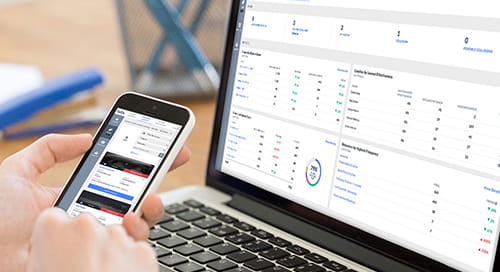Trucking Company Performance Metrics: KPI Fleet Management

If you don’t keep track of fleet management metrics, you’ll find it almost impossible to make objective decisions and improve performance over time. KPIs in fleet management are an important aspect of measuring efficiency and productivity and are integral to identifying problems, making corrections, and advancing as a company.
What are KPIs and why are they important?
Key performance indicators (KPIs) help you gauge progress towards intended goals. In terms of trucking company performance metrics, KPIs determine how well your staff and vehicles are performing. Keeping track of fleet utilization metrics creates clear and concise data that you can use to assess the overall performance of a fleet.
Additionally, this data provides measurable focus points for operational improvements. By having constant access to up-to-date information via a fleet management KPI dashboard, you can communicate and collaborate with your team and work more cohesively towards goals on individual and company-wide scales.
Types of fleet management technology KPIs
Telematics provides invaluable insights to fleet managers. As a result, they can keep track of KPI goals over a range of variables. When these key performance indicators are monitored effectively, managers are able to have greater control of their fleet. This results in a variety of cost-reduction and safety improvement measures as well as more stringent adherence to company policies.
Safety
- Risky driving behaviors: The Lytx DriveCam® Event Recorder can identify more than 60 risky driving behaviors, including unsafe following distances, speed limit violations, incomplete stops, and drivers not wearing seat belts. Fleet managers can quickly understand what is happening in the field through management dashboard KPI monitors that detect several driver distractions such as eating, drinking, smoking, texting, and shifting focus from the road. Monitoring these driver performance metrics can result in the reduction of distracted driving.
- Collisions: Over 90% of vehicle collisions are avoidable and caused by human error. Driver-centric tools prevent collisions by detecting deviations and alerting drivers so they are empowered to self-correct their own risky behaviors in the moment.
Productivity
Fleet metrics allow you to achieve maximum results and sustain them over time. As part of your fleet management, you can monitor arrival and departure times, routes taken, and hours of service, leading to increased efficiency across the board.
Costs
By tracking and monitoring key management metrics, fleet managers can cut down on the following costs:
- Maintenance costs: Fleet management metrics provide data on miles driven and fuel consumption, so you can address any irregularities before they turn into maintenance problems on the road.
- Legal costs: According to the Federal Motor Carrier Safety Administration, a crash involving injuries costs almost $200,000 and the average cost of a large truck crash involving a fatality is $3.6 million. As a result, committing to reducing risk and collisions for the wellbeing of the company and the public is a wise investment.
- Fuel costs: Using engine control module (ECM) data to monitor fuel consumption and efficiency, you can track idle time, miles per gallon, and any unauthorized mileage.
Customer Service
Effective fleet management translates to improved customer service and fewer complaints. You can find the nearest vehicle to any given destination for quick and speedy service. Using real-time data, you can let customers know accurate arrival times. As such, the overall customer service you provide is improved.
What fleet management KPIs should I be tracking?
What you choose to track will vary depending on your industry. For example, the goals you set for short-haul driver KPIs would be different than those for long-haul drivers. A good starting point is to determine what you want to improve. Then, develop a strategy based on those metrics.
Once you’ve decided what to measure, you need to set targets and decide how to assess your fleet’s performance in a realistic way. For the best success, you should communicate strategies to your team. Once you’ve established your plan, you can measure progress with access to real-time data. For this reason, many fleet managers use software solutions like the Lytx Fleet Tracking Service to collect trucking metrics and our Driver Safety Program to gather driver performance metrics.
How to start tracking your fleet
The most efficient way to track fleet management KPIs is to utilize innovative technology like Lytx. Our machine vision system and artificial intelligence (MV+AI) technology combines vehicle tracking with comprehensive data on fleet and individual driver performance for an unrivaled overview of operations. We connect fleets and data at an unprecedented scale:
- 24/7/365: our devices cover nearly every major road in the U.S. once every hour.
- One billion miles of driving data is collected every 10 days.
- Lytx technology is validated and backed by the largest and fastest-growing driving database of its kind, which is currently growing by approximately 200,000 new driving events each day, further training and improving its algorithms.
At Lytx, we filter out noise and clutter to identify real-time risk so you can focus on keeping your drivers safer and your business thriving. For more information on Lytx fleet management systems, please contact our team today.
